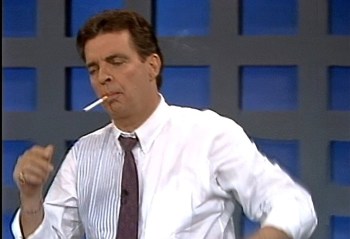Finally got around to watching the Merchants of Doubt documentary, based on the book with the same name. The Merchants of Doubt looks at how certain industries used public relations techniques to put doubt in people’s minds about the dangers of their products. This approach began with Big Tobacco fighting the overwhelming evidence that cigarettes cause lung cancer through a vigorous PR campaign revolving around “more science needs to be done.” Big Tobacco put enough doubt in people’s minds that smoking rates barely dropped for 20-30 years after the Surgeon General’s 1964 Report unequivocally stating that cigarettes did in fact cause lung cancer. And millions died from smoking during those years.
That technique of creating doubt was picked up by various other industries over the decades and today the oil industry is very much playing by the same playbook and has been frustratingly successful in creating doubt around the science that man is causing global warming. The movie starts with a very clever interview with a professional magician explaining that his job is deflection and explaining how the old “Three Card Monty” con doesn’t work without shills hidden within the public. “The whole con is about convincing the public that the shill is legitimate and independent,” says the magician, Jamey Ian Swiss.
From Stanton Glantz in the film: “The playbook Big Tobacco developed to attack science worked for 50 years. Other businesses looked at this and said, ‘boy, if this works for tobacco, we ought to be able to use that, too.'”

Glantz is interviewed extensively in the film. I realized that though this is a very familiar name in tobacco control circles, it was the first time I knew what he looked like and sounded like in interviews. Glantz was one of the first scientists to promote smoking bans and to talk about the dangers of secondhand smoke. He has been viciously attacked for decades for promoting tobacco control and smoking bans. I’ve personally seen trolls call him an awful, evil person.
“We spent a lot of time banging our heads against the wall (on tobacco control). These guys are rich, politically powerful … and they’re mean.”

Sure enough the movie shows a segment with Glantz on some talk show with some obnoxious host boasting to him that he smokes four packs a day and looks healthier and younger than Glantz at 42. I sure wondered who that obnoxious talk show host. It took one quick Google search to find out it was Morton Downey Jr. I actually vaguely remember the name, but I would have never figured out that was Morton Downey Jr. without resorting to Google. He was some right-wing talk show host in the 1980s whose show kind of ushered in “hate TV” shows like Jerry Springer.
I did some research. Yup. Mr. “I smoke four packs a day and I look great at 55” died of lung cancer. At the age of 68. Downey actually spoke out against cigarettes toward the end of his life and once filed a lawsuit against Howard Stern for insinuating that he was back smoking after quitting.
Anyway, I digress. There’s one major difference between the film and the book — a 10- to 15-minute segment in the film about tobacco’s role in pushing for fire retardants. This isn’t included at all in the book, but it was a fascinating part of the movie — and something I had never heard before.
In an investigative series done by the Chicago Tribune, reporters with the paper discovered that pounds of fire retardant chemicals being applied to furniture were showing up in household environments — and that studies had shown that these chemicals were both carcinogenic and didn’t really accomplish anything. They asked the question why were the chemicals even being applied if research showed they didn’t work.
The answer: Big Tobacco believe it or not. In the 1970s, thousands of people were being killed in fires caused by cigarettes — by people falling asleep in bed or on chairs while smoking. The tobacco industry was being pressured to develop a self-extinguishing cigarette, something that would have been expensive to develop. “What they (the industry) needed was a scapegoat and their scapegoat was furniture.”
Unbelievably, the vice president of the old Tobacco Institute (a lobbying arm of the tobacco industry, long since disbanded), Peter Sparber, infiltrated a national firefighters’ organization called the National Association of State Fire Marshals and then convinced that group to let him become its legislative representative. In that role, Sparber (a truly weird-looking dude with a porn stache) pushed for laws requiring fire retardant chemicals in furniture. The fire marshals’ group thought Sparber was working for them for free. Instead, the whole time, he was being paid $200 an hour by Big Tobacco.
There’s an infamous quote attributed to Sparber: “If you can ‘do’ tobacco, you can do just about anything in public relations.” Sparber now works for the Heartland Institute, a right-wing anti-global warming think tank. So, he is still in the thick of deflection and creating doubt to this day.
Anyway, it’s a solid documentary that will both entertain you and make you mad. It’s a solid addendum to the book for all the extra tidbits.



